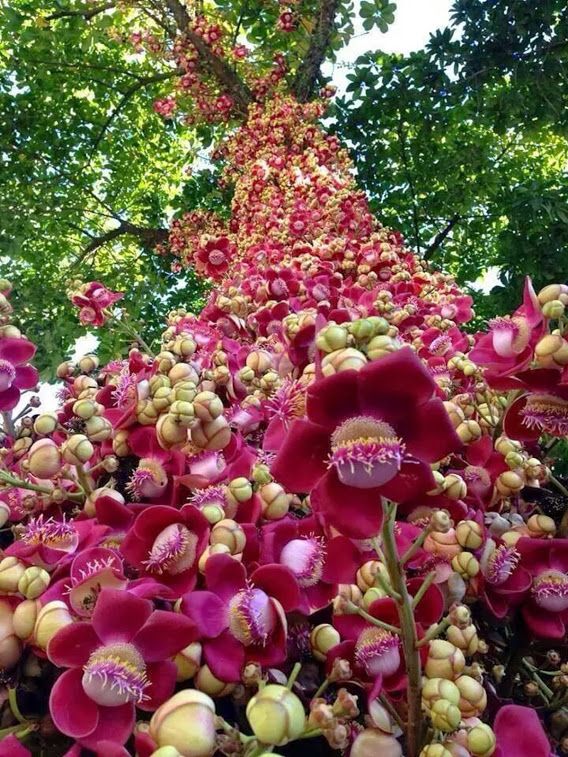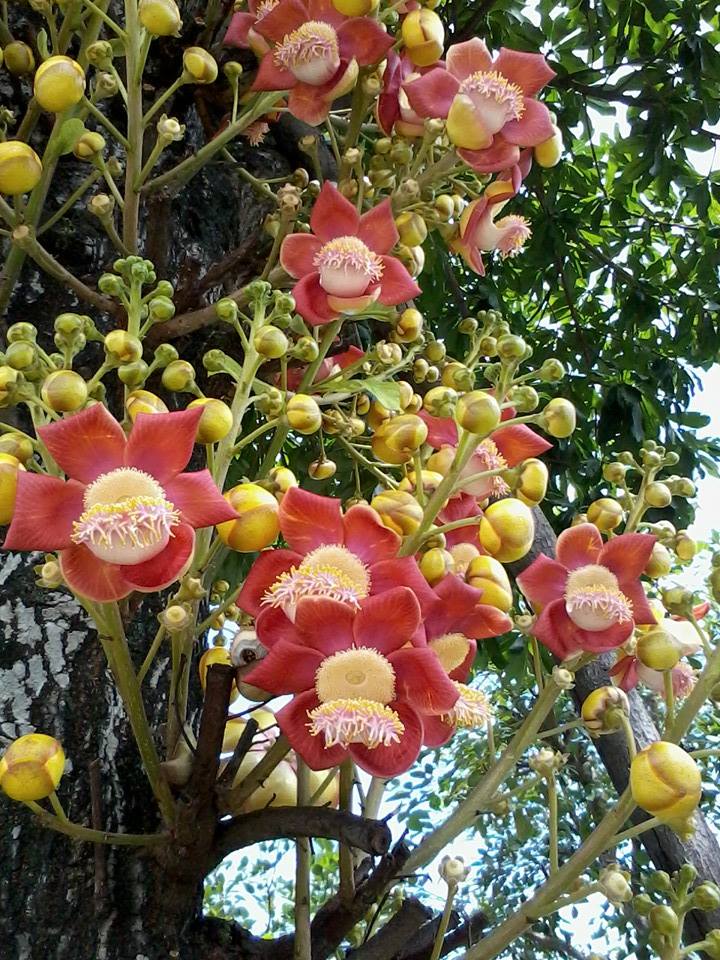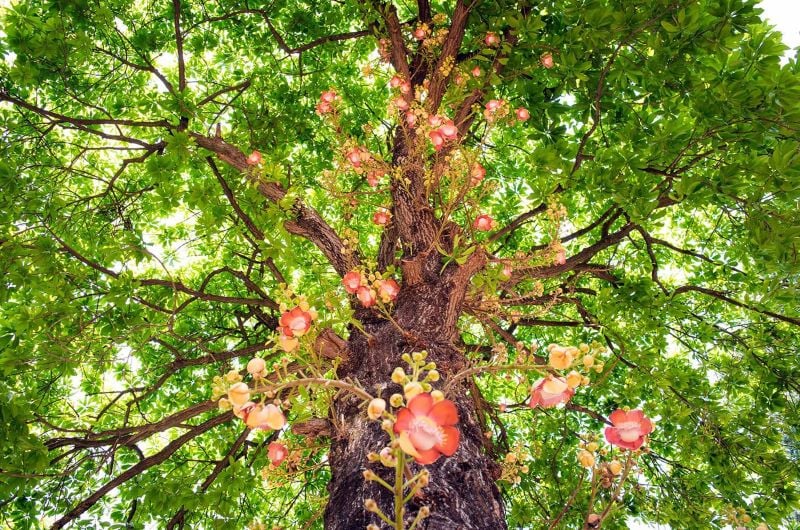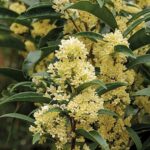The Cannonball Tree, known scientifically as *Couroupita guianensis*, is an exquisite tropical tree native to Central and South America. This tree, also called the Sala tree, boasts a stunning appearance and holds deep spiritual significance, particularly in Buddhism.

The Cannonball Tree’s beauty and rich symbolism make it a valuable ornamental tree, enhancing living spaces with its aesthetic appeal.
## A Spiritual Symbol and Its Meanings
The Sala tree, or the “unicorn tree,” is steeped in spiritual importance and boasts a multitude of practical applications.
### Spiritual Significance and Buddhist Symbolism
The flowers of the Sala tree are revered as the “flowers of the Buddha,” intertwined with sacred Buddhist legends. According to one legend, Queen Maya, the mother of Siddhartha Gautama (the historical Buddha), rested under a Sala tree while en route to her parents’ home to give birth. As she went into labor, the tree extended its branches like a protective hand, aiding her in a successful delivery. This event heralded the birth of Prince Siddhartha, who would later become the Buddha, bringing enlightenment to humanity.
Another tale recounts that as the Buddha was about to pass away and enter Nirvana, he lay resting under a Sala tree. Though it was not the flowering season, the tree suddenly blossomed, its petals gently falling to cover the place where he lay, bidding him farewell as he transcended to Nirvana.
These meaningful stories associate the Sala tree with benevolence, compassion, and wisdom. The flowers symbolize the innate purity of the human spirit and serve as a reminder of the importance of empathy, understanding, and approaching life with a carefree soul. In Theravada Buddhism, the Sala tree is often planted in sacred spaces like temples, creating an atmosphere of serenity and reverence.
### Feng Shui Applications
In feng shui, the Sala tree is considered a natural amulet, warding off evil spirits and dispelling negative energies. Planting a Sala tree in front of a home or in a garden not only beautifies the surroundings but also attracts good fortune, prosperity, and harmony for the household. This tree is especially beneficial for those with the Fire element in feng shui, helping to balance energies and enhance the vitality of the living space.
### Medicinal and Health Benefits
Beyond its spiritual significance, the Sala tree offers a plethora of medicinal benefits in traditional medicine. Various parts of the tree, including its flowers, leaves, and bark, contain valuable active compounds that promote health:
– **Antibacterial and Antifungal Properties**: Scientific research has demonstrated the Sala tree’s ability to inhibit the growth of bacteria and fungi, making it particularly effective in treating skin conditions and infections.
– **Digestive Support**: Juicing the young leaves of the Sala tree and using the extract for gargling can alleviate toothaches and gum inflammation. Additionally, the flowers are used to treat abdominal pain and digestive disorders.
– **Detoxification and Stress Relief**: Sala flower tea is not only delicious but also detoxifies the body, reduces stress and anxiety, and improves sleep quality. This tea also helps stabilize blood pressure and supports cardiovascular health.
– **Menstrual Regulation**: Sala flowers are used in traditional medicine to regulate menstrual cycles and alleviate associated discomfort in women.
## A Majestic Ornamental Tree
The Cannonball Tree, with its regal beauty and profound spiritual and health benefits, is indeed nature’s precious gift. It not only adorns living spaces but also enhances the quality of life, bestowing peace, prosperity, and happiness upon those who cherish its presence.

The Cannonball Tree’s majestic beauty and its spiritual and health benefits make it a true gift from nature.
## Growing and Caring for the Sala Tree
The Sala tree, with its graceful beauty, is easy to cultivate and care for, making it suitable for various living environments. However, to ensure its robust growth and radiant display, consider the following essential factors.
### Planting the Sala Tree
The Sala tree can be propagated through seeds, cuttings, or purchasing young saplings from nurseries. When planting in front of a house, carefully consider the available land area, as the mature tree’s canopy can be expansive and may obstruct the view or affect the flow of energy into the home according to feng shui principles.
For optimal growth, select a location with ample sunlight and spacious soil. Avoid planting too close to buildings or walls, as this may hinder the development of the tree’s canopy and root system.
### Care Instructions for the Sala Tree
– **Soil**: The Sala tree thrives in well-drained, nutrient-rich, and aerated soil. The ideal pH level ranges from neutral to slightly acidic (6-7). Enhance the soil by mixing in organic compost or manure to increase fertility and promote robust root growth.
– **Light**: As a sun-loving species, the Sala tree requires ample exposure to sunlight. Ensure it is not overshadowed by other trees or large obstacles, as insufficient light may hinder flowering and overall development.
– **Watering**: The Sala tree requires regular but not excessive watering. During dry seasons, increase the water supply to maintain soil moisture, but take care to avoid waterlogging. Conversely, during rainy seasons, reduce watering frequency to prevent root rot from overly soggy soil.
– **Fertilizer**: For balanced growth and beautiful blooms, fertilize the tree periodically every 1-2 months. Organic fertilizer or NPK fertilizer is recommended. However, avoid overusing nitrogen-rich fertilizers, as this may promote leaf growth at the expense of flowering.
– **Pruning**: Pruning is essential to maintain the tree’s shape and overall health. Remove dry, damaged, or weak branches to allow the tree to channel its energy into healthy growth. If the tree grows too tall or becomes unbalanced, light pruning can help shape and maintain its aesthetic appeal.
– **Pest and Disease Control**: The Sala tree may encounter issues like aphids, red spiders, or fungal infections. Regularly inspect the tree and promptly address any abnormalities with biological pesticides or natural methods to ensure the tree’s well-being and environmental safety.

The Sala tree may encounter pests and diseases, so regular monitoring and timely treatment are crucial.
## Special Considerations
– **Planting Space**: Given the Sala tree’s expansive canopy and considerable height, ensure the planting location does not interfere with daily activities or disrupt the landscape’s balance.
– **Prevent Waterlogging**: The Sala tree’s roots are sensitive to waterlogging. Implement an effective drainage system if planting in a garden to prevent root rot.
– **Monitor Growth**: Observe the tree’s growth regularly to adjust care routines accordingly, catering to its changing needs throughout its development.
With these guidelines, cultivating and caring for the Sala tree becomes more accessible and rewarding. Not only does it enhance living spaces aesthetically, but its spiritual and health benefits also contribute to a harmonious and prosperous environment.
The Ultimate Guide to Planting Mok Huong: How One Tree Can Change Your Fortune, Attracting Wealth and Prosperity.
Moc Huong, also known as the Agarwood tree, is a beloved symbol of good fortune in Vietnamese culture. Its distinctive fragrance and unique wood grain have made it a popular choice for those seeking to enhance their luck and prosperity. But where is the best place to plant this auspicious tree to maximize its positive effects? Let’s explore the ideal locations to harness the power of the Moc Huong tree and invite prosperity into your life.



































